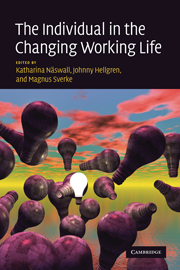Book contents
- Frontmatter
- Contents
- List of figures
- List of tables
- List of cases
- List of contributors
- Acknowledgements
- 1 The individual in the changing working life: introduction
- Part I Threats and challenges
- 2 New rules of work: exploring the boundaryless job
- 3 Changing work roles: new demands and challenges
- 4 The Demand-Induced Strain Compensation model: renewed theoretical considerations and empirical evidence
- 5 Job insecurity and employability among temporary workers: a theoretical approach based on the psychological contract
- 6 Independent contracting: finding a balance between flexibility and individual well-being
- 7 Work–family conflict in individuals' lives: prevalence, antecedents, and outcomes
- 8 My love, my life, my everything: work–home interaction among self-employed
- 9 Modern work and safety
- 10 Romantic relationships at work: old issues, new challenges
- 11 Ethnic diversity at work: an overview of theories and research
- Part II Individual attempts at restoring the balance
- Part III Intervention and promotion on the organizational level
- Index
- References
10 - Romantic relationships at work: old issues, new challenges
Published online by Cambridge University Press: 13 October 2009
- Frontmatter
- Contents
- List of figures
- List of tables
- List of cases
- List of contributors
- Acknowledgements
- 1 The individual in the changing working life: introduction
- Part I Threats and challenges
- 2 New rules of work: exploring the boundaryless job
- 3 Changing work roles: new demands and challenges
- 4 The Demand-Induced Strain Compensation model: renewed theoretical considerations and empirical evidence
- 5 Job insecurity and employability among temporary workers: a theoretical approach based on the psychological contract
- 6 Independent contracting: finding a balance between flexibility and individual well-being
- 7 Work–family conflict in individuals' lives: prevalence, antecedents, and outcomes
- 8 My love, my life, my everything: work–home interaction among self-employed
- 9 Modern work and safety
- 10 Romantic relationships at work: old issues, new challenges
- 11 Ethnic diversity at work: an overview of theories and research
- Part II Individual attempts at restoring the balance
- Part III Intervention and promotion on the organizational level
- Index
- References
Summary
Sex and romance develop in offices because that's where the people are. Men and women … are likely to get together in ways not mentioned in the corporate policy manual.
(Horn and Horn, 1982: 83)Over the past several decades, increasing numbers of individuals have been meeting their significant others at work. This means that in addition to professional relationships and social friendships in the workplace, romantic relationships are adding another dynamic into workplace interactions. Indeed, conditions in today's workplace are such that romantic relationships may well be inevitable. Given this, managers can take one of two approaches. The first and most frequent approach is to focus on preventing such relationships and their potentially negative consequences. However, a more recent development in the organizational literature provides a new perspective for how organizations view their employees; positive psychology and positive organizational behavior suggest that work experiences can promote mental health (Turner, Barling, and Zacharatos, 2002). Thus, the second approach changes the practitioner's primary focus from the costs of romantic relationships at work to include potential benefits. At a time when organizations are increasingly focusing on employee health, organizations may find ways to promote positive mental health gains (and limit any damage) for their employees through supporting romantic relationships.
Consistent with this new perspective, the purpose of this chapter is twofold.
- Type
- Chapter
- Information
- The Individual in the Changing Working Life , pp. 195 - 210Publisher: Cambridge University PressPrint publication year: 2008



